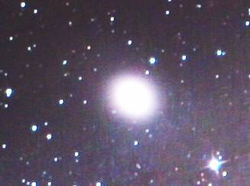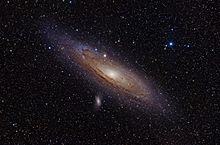- Messier 32
-
Messier 32 
Dwarf Elliptical Galaxy M32Observation data (J2000 epoch) Constellation Andromeda Right ascension 00h 42m 41.8s[1] Declination +40° 51′ 55″[1] Redshift -200 ± 6 km/s[1] Distance 2.49 ± 0.08 Mly (763 ± 24 kpc)[2][3][4][a] Type cE2[1] Apparent dimensions (V) 8′.7 × 6′.5[1] Apparent magnitude (V) 8.08[5][6] Notable features satellite galaxy of the
Andromeda GalaxyOther designations M 32, NGC 221,[1] UGC 452,[1] PGC 2555,[1] Arp 168,[1] LEDA 2555 See also: Galaxy, List of galaxies Messier 32 (also known as NGC 221 and Le Gentil) is a dwarf elliptical galaxy about 2.65 million light-years away in the constellation Andromeda. M32 is a satellite galaxy of the famous Andromeda Galaxy (M31) and was discovered by Le Gentil in 1749. M32 measures only 6.5 ± 0.2 kly[7] in diameter at the widest point. Like most elliptical galaxies, M32 contains mostly older faint red and yellow stars with practically no dust or gas and consequently no current star formation.[8] It does, however, show hints of star formation in the relatively recent past.
The structure and stellar content of M32 is difficult to explain by traditional galaxy formation models. Recent simulations suggest a new scenario in which the strong tidal field of M31 can transform a spiral galaxy into a compact elliptical. As a small spiral galaxy falls into the central parts of M31, most of the outer layers of the smaller spiral are stripped away. The central bulge of the galaxy is much less affected and retains its morphology. Tidal effects trigger a massive star burst in the core, resulting in the high density of M32 we observe today.[9] There is also evidence that M32 has an outer disk.[10]
Contents
Distance measurements
At least two techniques have been used to measure distances to M32. The infrared surface brightness fluctuations distance measurement technique estimates distances to spiral galaxies based on the graininess of the appearance of their bulges. The distance measured to M32 using this technique is 2.46 ± 0.09 Mly (755 ± 28 kpc).[2] However, M32 is close enough that the tip of the red giant branch (TRGB) method may be used to estimate its distance. The estimated distance to M32 using this technique is 2.51 ± 0.13 Mly (770 ± 40 kpc).[3][4] Averaged together, these distance measurements give a distance estimate of 2.49 ± 0.08 Mly (763 ± 24 kpc).[a]
A recent paper argues that M32 may actually be a normal (non-dwarf) galaxy that is actually three times farther away, outside the Local Group.[11]
Black Hole
M32 contains a supermassive black hole. Its mass has been estimated to lie between 1.5 and 5 million solar masses.[12]
Notes
- ^ average(755 ± 28, 770 ± 40) = ((755 + 770) / 2) ± ((282 + 402)0.5 / 2) = 763 ± 24
See also
References
- ^ a b c d e f g h i "NASA/IPAC Extragalactic Database". Results for NGC 221. http://nedwww.ipac.caltech.edu/. Retrieved 2006-11-29.
- ^ a b Jensen, Joseph B.; Tonry, John L.; Barris, Brian J.; Thompson, Rodger I.; Liu, Michael C.; Rieke, Marcia J.; Ajhar, Edward A.; Blakeslee, John P. (2003). "Measuring Distances and Probing the Unresolved Stellar Populations of Galaxies Using Infrared Surface Brightness Fluctuations". Astrophysical Journal 583 (2): 712–726. arXiv:astro-ph/0210129. Bibcode 2003ApJ...583..712J. doi:10.1086/345430.
- ^ a b Karachentsev, I. D.; Karachentseva, V. E.; Hutchmeier, W. K.; Makarov, D. I. (2004). "A Catalog of Neighboring Galaxies". Astronomical Journal 127 (4): 2031–2068. Bibcode 2004AJ....127.2031K. doi:10.1086/382905.
- ^ a b Karachentsev, I. D.; Kashibadze, O. G. (2006). "Masses of the local group and of the M81 group estimated from distortions in the local velocity field". Astrophysics 49 (1): 3–18. Bibcode 2006Ap.....49....3K. doi:10.1007/s10511-006-0002-6.
- ^ "SIMBAD-M32". SIMBAD Astronomical Database. http://simbad.u-strasbg.fr/simbad/sim-id?Ident=M32. Retrieved 2009-11-29.
- ^ Armando, Gil de Paz; Boissier; Madore; Seibert; Boselli et al. (2007). "The GALEX Ultraviolet Atlas of Nearby Galaxies". Astrophysical Journal Supplement 173 (2): 185–255. arXiv:astro-ph/0606440. Bibcode 2007ApJS..173..185G. doi:10.1086/516636.
- ^ Diameter = distance × sin(diameter_angle) = 6.5 ± 0.2 kly. diameter
- ^ Kepple, George Robert; Sanner, Glen W. (1998). The Night Sky Observer's Guide. Vol. 1. Willmann-Bell. p. 17. ISBN 0-943396-58-1.
- ^ Bekki, Kenji; Couch, Warrick J.; Drinkwater, Michael J.; Gregg, Michael D. (2001). "A New Formation Model for M32: A Threshed Early-Type Spiral Galaxy?". Astrophysical Journal Letters 557 (1): L39. arXiv:astro-ph/0107117. Bibcode 2001ApJ...557L..39B. doi:10.1086/323075.
- ^ Graham, A. W. (2002). "Evidence for an Outer Disk in the Prototype Compact Elliptical Galaxy M32". Astrophysical Journal Letters 568 (1): L13. arXiv:astro-ph/0202307. Bibcode 2002ApJ...568L..13G. doi:10.1086/340274.
- ^ Young, K. S. et al. (2008). "A critical review of the evidence for M32 being a compact dwarf satellite of M31 rather than a more distant normal galaxy". Chinese Journal of Astronomy and Astrophysics 8 (4): 369–384. arXiv:0809.1327. Bibcode 2008ChJAA...8..369Y. doi:10.1088/1009-9271/8/4/01.
- ^ Valluri, M.; Merritt, D.; Emsellem, E. (2004). "Difficulties with Recovering the Masses of Supermassive Black Holes from Stellar Kinematical Data". Astrophysical Journal 602 (1): 66–92. arXiv:astro-ph/0210379. Bibcode 2004ApJ...602...66V. doi:10.1086/380896.
External links
- StarDate: M32 Fact Sheet
- SEDS: Elliptical Galaxy M32
- Messier 32 on WikiSky: DSS2, SDSS, GALEX, IRAS, Hydrogen α, X-Ray, Astrophoto, Sky Map, Articles and images
Messier objects List M1 · M2 · M3 · M4 · M5 · M6 · M7 · M8 · M9 · M10 · M11 · M12 · M13 · M14 · M15 · M16 · M17 · M18 · M19 · M20 · M21 · M22 · M23 · M24 · M25 · M26 · M27 · M28 · M29 · M30 · M31 · M32 · M33 · M34 · M35 · M36 · M37 · M38 · M39 · M40 · M41 · M42 · M43 · M44 · M45 · M46 · M47 · M48 · M49 · M50 · M51 · M52 · M53 · M54 · M55 · M56 · M57 · M58 · M59 · M60 · M61 · M62 · M63 · M64 · M65 · M66 · M67 · M68 · M69 · M70 · M71 · M72 · M73 · M74 · M75 · M76 · M77 · M78 · M79 · M80 · M81 · M82 · M83 · M84 · M85 · M86 · M87 · M88 · M89 · M90 · M91 · M92 · M93 · M94 · M95 · M96 · M97 · M98 · M99 · M100 · M101 · M102 · M103 · M104 · M105 · M106 · M107 · M108 · M109 · M110See also Categories:- Dwarf galaxies
- Dwarf elliptical galaxies
- Local Group
- Andromeda Subgroup
- Andromeda constellation
- Messier objects
- NGC objects
- UGC objects
- PGC objects
- Arp objects
- LEDA objects
Wikimedia Foundation. 2010.

